CGS's Summer Camps Teach STEM With a Global Flavor; Act as a Bridge to College
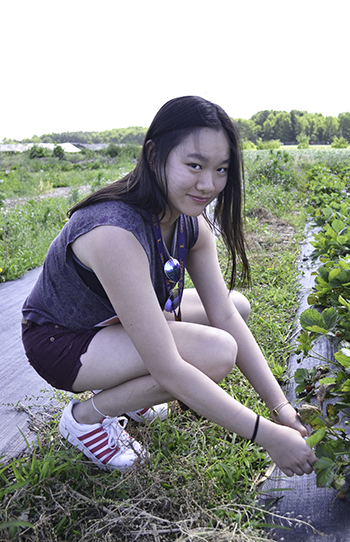
A student tastes an organic strawberry at the Student Sustainability plots.
June 7, 2016
While one might not think of Illinois' Center for Global Studies (CGS) as a STEM unit, two of its three summer 2016 camps address STEM topics… from a global perspective. Sustainable Futures, from June 5–10, addressed topics regarding sustainability. Global Health, in its first year, will address communicable diseases and epidemics. (The third, non-STEM camp is Intensive Arabic.) CGS Outreach Coordinator, Jeremie Smith, admits that their camps, while a lot of work, are valuable in a number of ways. Students benefit academically, experiencing a broad overview of sustainability issues, while going more in-depth on several. Students benefit socially: Smith sees his camps as a sort of bridge program that not only prepare high school students for the academic rigor, but life-style changes of college. And finally, students experience personal growth: many get a big dose of self-confidence, or get exposed to diverse students.
While CGS’s camps are for rising sophomores through rising college freshmen (4 or 5 students of this year’s students are attending Illinois in the fall) Smith says the majority of participants tend to be rising seniors.
“Which actually makes a lot of sense,” he explains, “because I think when students finish their junior year, they start taking seriously the search for colleges and thinking about college in a new way.”
Because Sustainable Futures is in its third year, the faculty who teach the various workshops “know what they like, what works well, and what builds continuity and students’ understanding,” Smith explains. Participants learned about groundwater treatment, filtering, and natural aquifers, including a lab on wide-damaging aquifers. In one session, students did a climate change computer simulation on a program developed by Professor Jonathan Tomkin, Associate Director of the School of Earth, Society, and Environment.
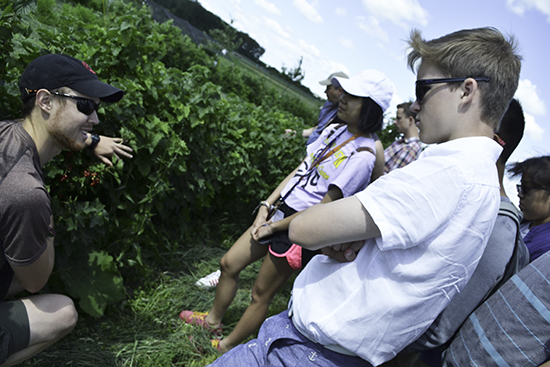
Illinois grad student Erik Stanek shows students some almost-ripe currants during a tour of the Woody Perennial Polyculture Project
During a tour of the Student Sustainable Farm, grad student Erik Stanek explained that the Woody Perennial Polyculture Project is exploring an alternative to growing just corn and soybeans, and suggest that farmers at least dedicate some farmland, such as around a field’s perimeter, to polyculture. According to Stanek, their plantings—row after row of chestnut trees, hazelnut, or apple trees, under-planted with not only red, but gold "Anne" raspberries, and currants, with swaths of pasture between the rows on which animals could peacefully graze—were designed to emulate an oak savannah.
During a field trip to Allerton Park, students heard about the environmentally-friendly policies being put in place regarding rainwater usage and solar panels, and even got to examine the solar panels see how they’re connected to the grid.
Also, students visited the new ECE Building on campus, which is aspiring to a Net Zero Energy rating and targeting a LEED Platinum certification from the U.S. Green Building Council. One of the structural engineers for the building led students on a tour and showed them what makes the building different than your average building, why certain things were done, how much money it’s supposed to save the university, and how much less energy it uses.
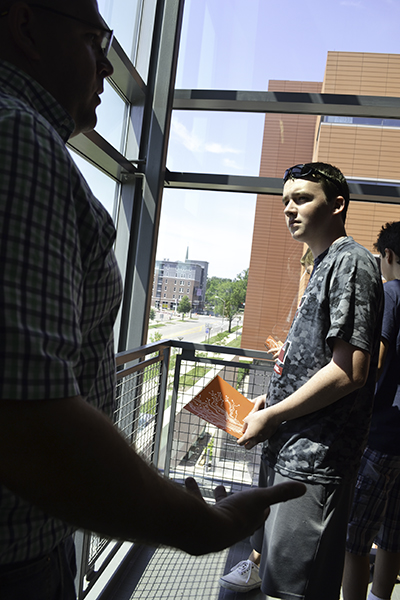
A Sustainable Futures participant learns from the ECE building's structural engineering about its sustainability features.
New for this year, CGS also ran a Global Health camp from June 12th through 17th. According to Smith, nine of the eleven participants were girls and had a strong interest in health professions (some or hoped to become doctors) or medical science. He reports that "They also have a humanistic bent—they’re interested in learning about other cultures and languages and like the idea about learning healthcare systems in different parts of the world. Will all of them end up working in a global health field? No, of course not. But a couple of them might have their passion confirmed and maybe a couple of them realize, 'I’m not interested in it as much as I thought.'".
One activity the Global Health students did was a field trip to Peoria’s Communicable Disease Center, an experimental and simulation center where they run simulations on epidemics. Students got a chance to do both computer simulations and did hands-on activities with dummy patients.
While Smith says half of the lessons learned in his program are academic (students learned about sustainability, global medicine, or Arabic), he suggests that the other half are “social lessons about being a student at a university, about interacting in a very diverse community, sharing a dorm room with another student you just met.”
A former high school teacher, Smith discovered first-hand the need for summer programs like those CGS has developed. He used to find that a lot of his students, even the successful ones, had difficulty adjusting to college. “There’s a big jump from high school to college, even if you go to quite a good high school. More and more, I saw students that I was working with…being involved with summer academic programs and that this gave them both some experience doing college-level work and also the social lessons of being away from home and being in a residence hall.” Then when he came to CGS, his experiences running their fledgling summer program reiterated how beneficial a summer experience on campus could be for high school students.
“It’s the kind of thing that gives them confidence that they can be successful at a university. They can get a taste of college life for a week or two, and I’ve just been impressed with how those students who have participated in past years’ programs have gone on to be successful college and university students—some of them here.
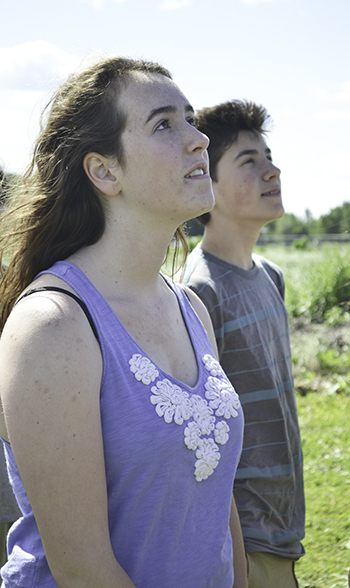
During a tour of the Student Sustainability plots, students do a little bird watching.
In addition to being a bridge program, Smith sees his summer camps as a catalyst to get students thinking about college: “It’s a bridge that allows high school students that are successful and hardworking high school students to have an experience at college life in a structured environment for a short period of time. I would hope that gives them a shot in the arm to finish high school strong and to take seriously the search for a good college program that suits them well. So I think that’s the main thing; I look at the programs as being a really good bridge opportunity.”
Smith also believes the diversity among the camps’ participants is another plus. “Again, this wasn’t one of our intentions,” he admits, “but it’s turned out to be that we draw a really diverse collection of students: geographically from all over the country, and ethnically from people’s backgrounds. And it’s been really fun to see those students interact with each other—a lot of for the first time.
Smith shares an anecdote about the diversity among last year’s participants, which he calls “a real boon.”
“We had two students from the Navajo reservation participate in Sustainable Futures. Both of these students had limited experience outside of their community and certainly had never been to a giant university like this. But also the students they interacted with here, maybe half of which are from the Midwest, had never really interacted with a peer from a living Native American community.”
Another activity, classified as neither academic nor social, blatantly prepares students for college: dinner with some academic advisors from across campus. On their applications, CGS staff had students indicate in which majors or fields they might be interested, then arranged to have advisors from many of these majors attend. Smith says 10–12 advisors typically attend the dinner from all over campus, such as from engineering, liberal arts and sciences, biology, education.
Smith says students not only benefit academically and socially, but personally—they experience an increase in self-confidence. He reports that students who have completed the program have a whole new attitude about starting college: “Oh, I can do this work. I can do this. I’m excited for it.”

At the Student Sustainable Farm, students experience a greenhouse full of tomatoes that were planted in early March and will be ready for harvesting shortly.
Smith shared another feel-good story about the two kids from the Navajo reservation. Smith was the reason they had attended last year’s camp in the first place. When he visited a high school in the middle of a desert in Arizona, one of the teachers told him, “Our students aren’t prepared for it, academically or socially.” Continues Smith: “But he told me that they just lack confidence, so that’s the biggest problem.”
Thinking of CGS’ summer program, Smith suggested having a couple of the school’s students attend the camp, then got them scholarships.
According to Smith these two students “had an incredible experience, did really well, and thrived.” During his closing presentation, one boy, Ezekiel, was talking about what he had learned about environmental sustainability. He added that from a Navajo cultural perspective, ’This is how we’ve always kind of looked at the Earth; something that should be preserved.’ And had this confidence in his voice and willingness to share his perspective, comfort with feeling like his perspective would be valued, and it was a transformative experience for him.”
But the story gets even better. Smith visited the school again this past winter. Those two kids, who happened to be home after their first semester of college, had heard from their friends, “Oh, Mr. Smith’s back at the school.” So they came to the school to visit him.
What one student told Smith confirmed what he believed was one of the major benefits of his camp: “Zeke was telling me that he had been really worried about starting college, and had gotten a scholarship to go to Utah State, but he didn’t know if he could handle a big university, being away from home and his community,” explains Smith. “Coming to the University of Illinois gave him the confidence, and it really changed the way he looked at college.”
Smith thinks a lot of the students who participate in the program are in a similar position for different reasons. “They’re a little worried about college; there’s a lot of pressure on high school students to get into college, and to find money for college.” Smith adds that they’re also being told: “You’re 17 years old; you should know what your majors gonna’ be!”
In addition to improving students’ self-confidence, Smith believes his camps have the potential of being a journey of self-discovery for participants. And he tells them this during his opening talk: “If you open yourself to it, the most you will learn during the week you’re here is about yourself. Like who you are, what you’re interested in, what do you bring that’s valuable to a group that’s working together and collaborating together?”
He says they’ll also learn: “What do you like about a large University? What don’t you like about it? Because there’s pluses and minuses to all of those things.”
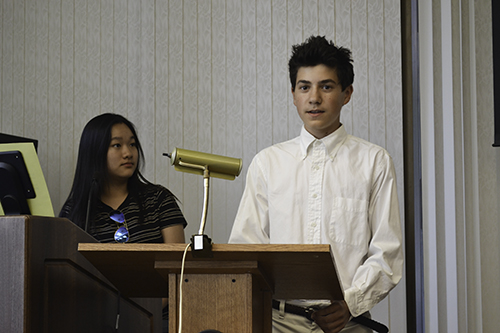 Mihir Thakar, a Senior at Monta Vista High School in Los Altos, California, and Jack Easley, a junior at University Laboratory HIgh School in Urbana, Illinois present their project, "The Future of Our Food: Can Our Growing Population Be Sustained by Our Food Production?" during the final Project Presentations session of the Sustainable Futures camp.
Mihir Thakar, a Senior at Monta Vista High School in Los Altos, California, and Jack Easley, a junior at University Laboratory HIgh School in Urbana, Illinois present their project, "The Future of Our Food: Can Our Growing Population Be Sustained by Our Food Production?" during the final Project Presentations session of the Sustainable Futures camp.While the camps only last for one week, the students form a network and stay in contact long after the camp is over. Smith, who’s a member of the Facebook page CGS sets up for each camp, admits, “There are still conversations that go on,” He reports seeing communications between students who did the camp two years ago, something like: “’Hey, Lauren, what are you up to? I’m in my second year at Kansas. What are you doing?’ and the response, ‘Oh I decided to go to U of I. I’m staying in the same dorm we stayed in two years ago.’ Smith believes they’re “learning how to make adult relationships, which doesn’t mean you live in the same town necessarily….kind of extending your world view in a lot of different ways.”
In addition to Facebook, many students send follow-up emails, “Cause I tell them, ‘Let me know what you’re up to.’” And they do. In fact he’s written letters of recommendation for a couple of them for college admittance or scholarships. He reports that quite a few past campers were in the process of applying, had already applied, or even a couple that had already been accepted where they come in the program. He says probably 4 or 5 students in this year’s camps have already been admitted to Illinois for the Fall.
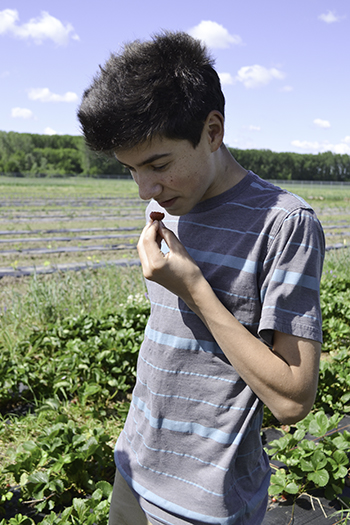
A student tastes an organic strawberry during a tour of the Student Sustainability plots.
One of the things Smith is proudest of, is their scholarships: “We’ve been fortunate in that our budget model has allowed us to offer scholarships to students who ordinarily would never be able to participate in these kinds of programs,” he admits. “So students from the Navajo reservation, but also students from our community who are good hard-working students. Their parents are working-class or immigrants and this University of Illinois program is outside of their price range in a lot of ways. But we’ve been able to provide scholarships,” says Smith. “That’s been something that I’ll remember and be proud of long after I’m not here."
He’s also proud of the impact the camps have had: “I think for the most part we’ve been successful. I give a lot of credit to the faculty members that lead an engaging and really interesting course. The students do seem to, I mean the program is only 5 ½ days, and they get so much out of the program.
But it’s not just the students who reap benefits. While CGS didn’t intentionally design the program as such, it’s turned out to be an excellent recruiting tool for the university.
“A lot of the students are really excited about the campus, and they work with top-notch U of I faculty members that teach the courses, getting the experience of building rapport with a professor. So I think that quite a few of the students in the past years have ended up matriculating to the University of Illinois.”
He adds, “If you run a great program, and students have a really great experience, then inherently, a lot of them are gonna want to come here for their full college experience.”
Story and photographs by Elizabeth Innes, Communications Specialist, I-STEM Education Initiative.
More: 8-12 Outreach, Center for Global Studies, Summer Camp, Sustainability, Undergrad Outreach, 2016
For more articles about CGS's Sustainable Futures Camps, and the Woody Perennial Polyculture Project, see:
- Sustainable Futures Workshop Stokes High Schoolers' Passion: Sustainability
- Highschoolers Learn About Global Health at CGS' First-Ever Global Health Camp
- Chancellor's Fellow Wolz Hopes to Revolutionize Agriculture ViaWoody Perennial Polyculture
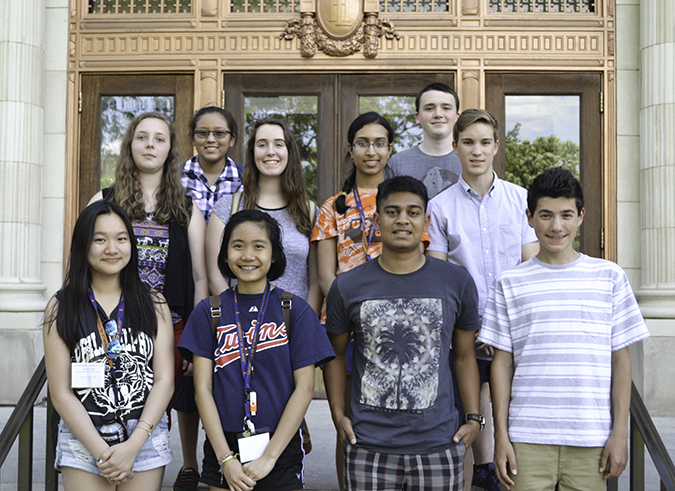
Participants in the 2016 Global Studies summer camp: Sustainable Futures